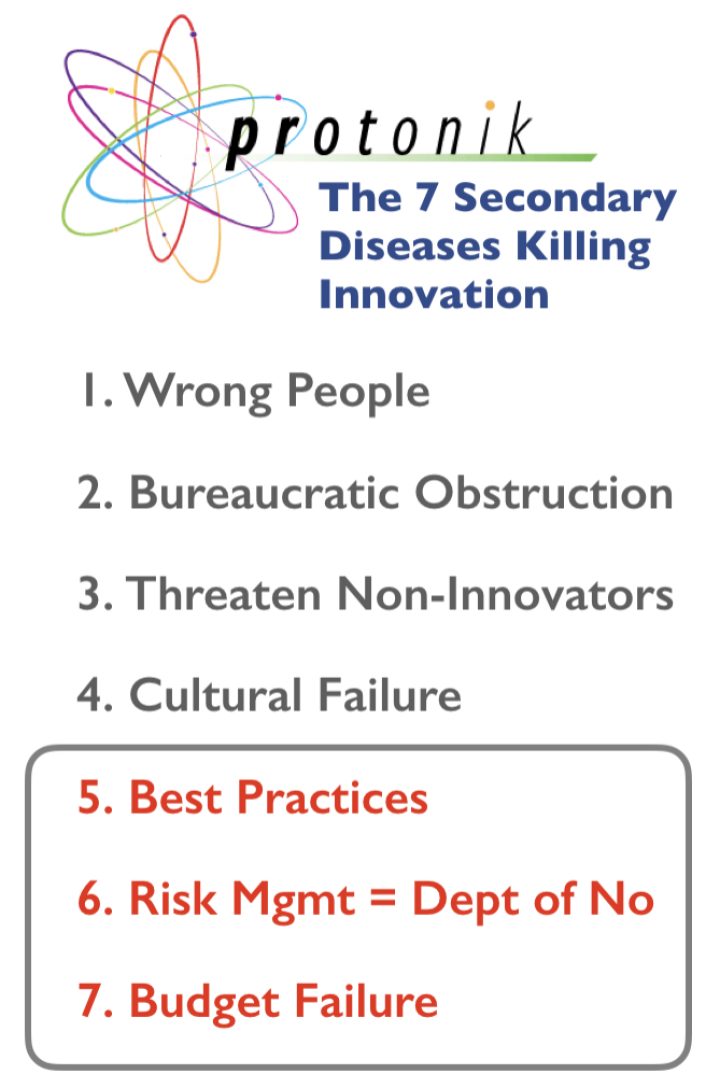
7 Secondary Diseases that Kill Innovation: The Departments of No

“Yes is a challenge. Yes means making a commitment. Yes means figuring it out barring all other obstacles and challenges.” Ivy Slater
.
As I begin this final post about the diseases that kill innovation, we encounter the three departments of no.
These three departments lead to what Rick Nason calls “The Bubble Wrapped Company” in his excellent book on risk management. Businesses too often believe that following guidelines and exerting control through these three areas (along with, perhaps, an ISO standard or two) can eliminate risk.
Yet I have a good friend who teaches young commercial pilots about risk. A commercial pilot himself, he asks them to describe a situation without risk. There is only one answer: the airplane is parked at the gate. Of course that’s not possible. So pilots, then, must be trained to ACCEPT that they are taking risks so they can learn how to take the right ones and do so with AWARENESS (sometimes specific training) for how to handle themselves if things go awry.
It’s a rare bureaucracy that works with the wisdom of a good airline pilot. Best practices are established thinking chosen in the hope of eliminating product or management risk. Risk managers are hired to “control risk”. And budgets are weaponized to kill anything with any amount of risk. In truth, these actions primarily prepare corporations for their own demise.
To be an airline is to accept risk as an inherent business reality. Being in business takes it a step further. In business, risk is not merely a business reality. Embracing risk is the only way for a business to succeed and prosper; to avoid risk is to limit your future.
Corporations need to embrace the reality that they must innovate to create a future. That means risk is key to their survival. So let’s talk about the departments of “no”.
Disease #5: Best Practices & Reverting to the Mean.

Best practices seem like such a smart idea. In fact they’re so smart that they have become part of the ISO standard and who doesn’t like a good standard? Wikipedia’s entry even says they are a feature of “accredited management standards” (which is what ISO is – but it adds even more important sounding words to the description).
But best practices like all methods and formulas are primarily popular because when things inevitably fail, there’s built-in plausible deniability — “we used best practices”; “we used the #JTBD method”.
A best practice, method or formula says “it’s not our fault” even though the mere act of relying on a formula, practice, or method may be exactly what guaranteed failure.
For example, the JTBD method or methodology inherently includes limiting assumptions about the kinds of value innovation delivers. By eliminating a great many opportunities to deliver value JTBD rarely discovers ground breaking change and primarily delivers incremental “small ball” change. Yet, the claims made about it are big enough that no executive committee will challenge a development team which says “we are relying on JTBD”.
Even worse, best practices often kill innovation.
The idea of a best practice isn’t so bad — folks in a company saying “we should usually do things this way”. That’s not how it turns into reality, though. Companies turn “practices” in “laws” — often implemented at the recommendation of the massive consultant industry who reap tremendous profits from putting best practices in place. They are no longer treated as the simple good ideas they should be – but bureaucratic absolutes.
It is the practice of raising “good ideas” to law that makes best practices disastrous for innovation. Unfortunately, that horse has already left the barn and is damaging companies around the world.
 Aren’t best practices, well, best? No. They are the same thing everyone else does — they are average. It’s not possible for something to become a best practice if it’s leading edge.
Aren’t best practices, well, best? No. They are the same thing everyone else does — they are average. It’s not possible for something to become a best practice if it’s leading edge.
It gets worse, though. Innovation quite often makes best practices obsolete – and does that very quickly. And here is one of the very serious errors in best practices: they refuse to change quickly — the intent is that they are “best” forever.
Corporations are caught between needing innovation and believing in best practices. Best practices almost always win – but corporations try not to let it look that way. Knowing they need an appearance of innovation, they just let the best practices gut innovation until it’s no longer innovative. The result does, in fact, kill innovation except does so with plausible deniability — there’s no one to charge with manslaughter.
Best practices are also boxes. And it’s ironic that the same organizations who love them most also hold regular seminars telling employees they need to “think outside” those boxes the bureaucracy just built.
Sometimes best practices CAUSE the problems innovation needs to solve. And sometimes getting rid of best practices IS the right innovation.
Bob Lutz, writing about his time at GM, observes that modern cars look sleek because they have minimal clearance between wheels and the wheel well. He was frustrated because GM cars never had this tight design so they never looked sleek — a part of why they’ve looked so dated.
As he investigated he discovered a “best practice” that had been in place for decades. This practice required that wheels be tucked in under the car to protect tires and that there be added clearance with the wheel wells.
In other words, GM cars didn’t look dopey because of poor design choices. They looked dopey because a best practice, hidden deep in the recesses of GM, forced their cars to look outdated.
Best Practices Revert to the Mean.
Read carefully how enthusiasts describe best practices and it’s clear they are the fastest way to make your company/product just like everyone else’s — once something becomes a “best practice” it is entrenchedly average. I sometimes wonder if best practices aren’t one of the reasons US product assortments are becoming more and more bland.
Innovative new products or services MUST create a competitive edge for a company – something different to be a base of company health for years or decades to come. There is NO way your company can build that competitive advantage when innovative new products have to be built under a dictatorship of best practices.
What can be done?
The first step goes to my last post on this — executives have to set the tone for innovation and make it clear that those making new & exciting things must, themselves, design and develop without any hindrance from best practices.
If, in the process of design, innovators step over a best practice then maybe that should be looked at. At that time, the practice police must not be given an upper hand. Unfortunately, in a bureaucracy clear, simple rules too often win out over the messy complexity which is needed to build future company strength.
Companies desperately need innovative new things. A best practice should only be imposed back onto the project IF it is useful.
 Disease #6: Risk Management as the Department of “No”
Disease #6: Risk Management as the Department of “No”
The more I’m involved with corporations the less I like standards. Certainly they serve excellent roles within a technical field — like standards for electrical plugs. But standard organizations moved far beyond their logical roles and even rule areas where they should not be adopted like in Risk Management — the department most often known as the “Department of NO!”.
No corporation survives in the long run without embracing risk – pro-actively choosing risks to take.
So EVERY COMPANY needs to make embracing smart risk the most important role of risk management — to choose innovations then anticipate and minimize the risks that could cause them to fail. This should include the risk management group minimizing organizational risks (like destructive best practices!). Risk management must also plan for how the company should embrace the innovation if it is a massive success.
Unfortunately, the ISO standards on Risk Management don’t encourage a positive sense of risk managementt. In my experience, most corporations believe they are doing good risk management when they create long lists of backup plans in the event they decide a project is failing.
In big corporations, then, risk management quite often means planning to fail by creating long lists of secondary options so executives are prepared to quickly bolt for the doors at the first sign of danger. Truth is that they usually bolt rather than stick with the hard work of developing a highly profitable market for an innovation.
Small company teams are a bit better. Quite often they have to do true risk management and develop what’s popularly called “grit” today. When they run into obstacles they usually don’t have stable profits to fall back on so they can’t afford to think backup plans are a good idea. Small companies are, in a sense, working without a net — failure is not an option (the title Gene Kranz chose for his book about NASA’s Mission Control). As a result, entrepreneurs put in long hours and take financial risks even when the future isn’t clearly understood.
To lay out an extreme, companies should compare their courage with the innovation practices of a Hollywood studio. When a Hollywood movie releases, first weekend numbers determine the future of the movie. If they are low, the studios immediately put crisis management in place.
Companies need to watch out for itchy risk management trigger fingers like these. Only an exceptionally few companies should use the Hollywood approach (even most Hollywood studios shouldn’t).
Rick Nason has written an exceptional book about risk management – drawing on his experience in the financial fields. I highly recommend it. At core, he fundamentally assumes we live in a complex world and that any risk management activity is an activity of managing amid complexity. (He has also written about complexity and contrasts complexity with the complicated management approach presumed by corporations, too many consultants, and, I’ll add, ISO standards.)
Let’s remember what Rick calls “The Bubble Wrapped Company”. Executives do seem to want to bubble wrap their companies to prevent any damage even though damage is inevitable.
What’s worse is that how a company responds to damage is also often exactly what makes a company succeed. Here I think about the New Coke debacle. While it was a debacle, Sergio Zyman observes that it gave Coke an opportunity to reignite passions around the Coke brand. In their crisis management, they embraced that opportunity and that was key to the future of Coca-Cola.
 Disease #7: Budget Failure.
Disease #7: Budget Failure.
I’ve left budgets for last. Partly, budgeting failure is quite often a symptom of all the other diseases. Politics, people, failure to market well, and strategic mis-alignment can all be seen when you look at how budgets are allocated. When there is failure in any of the Four Deadly or the Seven Secondary Diseases, it shows up in budgets.
On the other hand, budgets are such a critical element of success for innovation that we must talk directly about them.
Lest anyone think I believe innovation projects need to be teeming with cash resources, I find that budget constraints can even be a powerful driver of creativity and innovation. This is one place where innovation budgets are quite tricky. The budget needs to be high enough that projects aren’t starved into failure yet not so high that the demand for creativity is lessened. There is no formula for this — it requires smart management of resources.
That said, some companies choose not to allocate specific budgets for innovation but ask departments to fund innovation out of their existing budgets. This is, of course, a major problem and will ensure that either ongoing business suffers or innovations fail…or both.
What’s needed is a process which allocates budgets strategically — with a clear focus on what the company needs to achieve.
Let me use marketing budgets, the area I know best, as an example of how bad budgeting kills innovation. Budget error starts when too many companies are loath to pay for the right research. Quite often they do this saying “market research doesn’t PROVE success”. The right answer is that NOTHING proves success. But it’s folly not to learn the important market realities we will face including early responses to product ideas.
More fundamentally, innovation won’t succeed when too many corners are cut in market research. One corner cut far too often is to demand that market research around innovations never get its own budget — but be combined with on-going research. Executives claim “it’ll be just fine — we’re doing research”. Please read my earlier post about the market research errors that are one of the Four Deadly Diseases.
Too many companies also refuse to allocate customer oriented marketing teams to innovation projects. Generally they see this as a budget savings because they figure it’s what engineers or designers do and they’re already paying for engineers. First, let’s be clear that I’m talking about customer marketing roles — not the engineering and finance oriented roles. Second, engineers and designers do think about end customers. But they don’t do this with responsibility for the most important question: Will it sell?
So it turns out companies support innovation by asking marketing finance folks estimate market size before we have any realistic idea of who will care enough to buy the product. Market size estimates are also a tremendous problem for startups because investors demand them unaware that the customer isn’t clear yet. Customer oriented marketing would, in fact, figure out WHO the likely market is who almost turns out to be different from early theories that were embraced. Successful marketing of innovation must START with customer oriented marketers.
The engineering related marketing roles are critical as something becomes productized — managing a wide range of details. However, my experience is the customer gets lost as engineers talk with engineer/marketers. (By observation, I’m convinced Samsung US suffers this problem quite badly. Far too much tech without purpose comes out of their operation.)
My hunch the Jobs to Be Done myth has done us no favors here. JTBD shifts an important marketing role which requires tremendous human subtlety to engineering or design. The result is a shallow, superficial customer understanding — one that permeates JTBD writing regardless of which JTBD camp one joins
Skilled innovation marketers have unusual ability to perceive how products and product capabilities lead to sales. Engineers generally focus on those parts of the product which satisfy those who buy it — if they ever do. Innovation success requires understanding those customer subtleties — and budgets need to make sure that this ability is deeply involved early on.
Too many companies also fail to allocate sufficient marketing communication or advertising budget. The myth of the internet is that, somehow, things that used to be expensive are now free. While we clearly know this is false today, the myth remains strong during budgeting and among executives who wish it were true.
Yet well tested marketing understanding knows that a new product entering a market needs at least twice the communication dollars as it will eventually need when it has become established.
One dysfunctional budgeting approach is to demand that marketers promote innovative new products and services within the same budgets that must drive ongoing business. Another happens heavily in public companies where ad budget cuts become the fastest way to hit quarterly or FY-end numbers — killing any momentum the marketing team might have built (or killing any early emergence that is developing).
It is, in fact, incredible short-termism — a habit that seems to have become a way of life at far too many American companies (and at companies around the world from what I hear).
Marketing budgets are just one example of how companies budget their way to innovation failure. Innovation budgets should be allocated separately from departmental budgets. Innovation budgets must include all phases of work required to hit the market driving for success. Those budgets need to be maintained during the first years on the market both to make rapid product improvement and to establish innovation gains in 3-4 years of marketing.
While I have focused heavily on marketing here, I’m hopeful that these specifics will help others consider their own area and the ways budget mistakes kill innovation in their specialty. And, please add comments if you’d like — it helps everyone to read about the dysfunctional budget practices which kill innovation.
 Last Thoughts
Last Thoughts
We arrive, now, at the end of the 11 diseases which kill innovation. As Bruce McTague pointed out to me, this list reflects an incredible gauntlet of challenges past which innovation must run – especially in corporations.
So the list seems to make it clear why dramatic innovations so rarely come from large corporations — at least it adds, hopefully, to the understanding of innovation failure. But let’s not give smaller organizations a free ride. They also suffer from these 11 diseases.
Marketing errors are extremely common among startups — where the dominance of engineers and designers in the early process along with a scarcity of money ensures almost every startup makes major marketing mistakes. And I’ve even seen some incredibly dysfunctional startup cultures which included assumptions that ensured their failure — assumptions like cultural preferences including “bro-culture” or demands for soul killing work hours.
And then there are problems which come from angel, venture, or bank funding. Attempting to raise capital, small organizations often take on the trappings of far larger companies which brings disease along with the trappings. Best Practices are one example. I’ve also seen many startups make the mistake of hiring brand ad agencies just to make investors happy — but brand agencies are the worst possible choice for innovation communication.
Quite often, small companies hire marketers or retain marketing resources who have only managed successful products — never fighting the much different battle of building market momentum from a full stop. (Quite often this is justified with “but they’re in our category”. Product category experience is NO GUARANTEE of experience with innovative products.)
I won’t stop this writing with a depressingly long list of diseases. Over the next few months I’ll post about ways to fight the diseases — even some responses which are easier than we might expect.
That said, I’ve focused on diseases first following Chesterton’s advice.
“It isn’t that they can’t see the solution. It is that they can’t see the problem.” G.K. Chesterton
Now that the problems are on the table, solutions come next.
©2019 Doug Garnett – All Rights Reserved
Through my company Protonik, LLC based in Portland Oregon, I work with clients to drive innovation success with better marketing of new and innovative products and services — work which needs to start before market analysis. I also work with clients attempting to bring new life to Shelf Potatoes or take their existing products to new markets. You can read more about these services and my unusual background (math, aerospace, supercomputers, consumer goods & national TV ads) at www.Protonik.net.
Categories: Business and Strategy, Complexity in Business, consumer marketing, Innovation, marketing, Methodology, Uncategorized

Posted: April 1, 2019 19:25
7 Secondary Diseases that Kill Innovation: Problems of People, Politics, and Culture | Doug Garnett's Blog
Posted: June 4, 2020 14:37
Brain Science: How Procedure Shuts Down Innovative Thinking | Doug Garnett's Blog